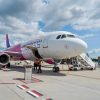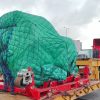 Each week, a total of 28 brand new aircraft roll off the assembly lines of major manufacturers. During any given month about 50% of those aircraft crafted by Airbus and Boeing are going to the Asia-Pacific region, according to Flightglobal. Cornered by this remarkable pace, Asian carriers need to gather from 10 to 12 pilots for each new plane. And as this issue is yet to be solved by local CAAs, airlines and governments, it does make one wonder, whether there is a way out of this seemingly unsolvable staff shortage equation.
Each week, a total of 28 brand new aircraft roll off the assembly lines of major manufacturers. During any given month about 50% of those aircraft crafted by Airbus and Boeing are going to the Asia-Pacific region, according to Flightglobal. Cornered by this remarkable pace, Asian carriers need to gather from 10 to 12 pilots for each new plane. And as this issue is yet to be solved by local CAAs, airlines and governments, it does make one wonder, whether there is a way out of this seemingly unsolvable staff shortage equation.
Divergent approaches stem from the Asia Pacific region to address the shortage issue. Nevertheless, none of them show potential success in the near future and some of them may even turn already slippery safety issues of the region into huge problems. Japan, for example, has recently introduced new pilot age limits, reaching the age of 67, while previously already raising the age limit in 2004. This approach, however, even with certain limitations for older pilots, seems like a bad idea in the industry were 80% of all accidents can still be attributed to causes related to human error. And as the situation gets worse, something meaningful needs to be done and it needs to be done now.
According to the International Air Transport Association (IATA), Asia Pacific airlines now account for about a third of global air passenger traffic and that number is expected to remain on a fast track for at least a couple decades and will reach 42% within next two decades. Orders of the airlines within the region currently stand at 1 600 and actually exceed the fleet of the operating ones. However, as this rapid expansion continues, many experts fear soon there will be literally no experienced workforce to pilot or maintain the delivered machines. At the same time, while the region’s airlines were dominating the news regarding aircraft tragedies that mostly were pointing to human factor throughout all of the last year, market expansion seems to be on top of all of the region’s carriers’ minds, sometimes even pushing even safety concerns into the shadow.
“The extraordinary expansion of aviation in the Asia-Pacific, sadly, has not been accompanied with the same attention to safety standards and clear solutions to the HR crisis.  While some carriers were able to somewhat fill the gap by attracting foreign talent with competitive salaries in the past, nowadays, other regions, for instance Middle East, are way more appealing to expat aircrew on that matter,” explains Skaiste Knyzaite, the CEO of AviationCV.com. “Nonetheless, the region still could be a good starting point for pilots, as, for example Vietnam’s VietJet Air expat Airbus A320 first officers today can transition to captains in as little as 1-2 years, whereas in the US this process could sometimes take more than 15 years. However, while definitely being a great kickoff for expats, the solution for local workforce deficiency is still nowhere to be found and without it, no one knows for how long the region can maintain the upward trend.”
While some carriers were able to somewhat fill the gap by attracting foreign talent with competitive salaries in the past, nowadays, other regions, for instance Middle East, are way more appealing to expat aircrew on that matter,” explains Skaiste Knyzaite, the CEO of AviationCV.com. “Nonetheless, the region still could be a good starting point for pilots, as, for example Vietnam’s VietJet Air expat Airbus A320 first officers today can transition to captains in as little as 1-2 years, whereas in the US this process could sometimes take more than 15 years. However, while definitely being a great kickoff for expats, the solution for local workforce deficiency is still nowhere to be found and without it, no one knows for how long the region can maintain the upward trend.”
According to the executive, while many solutions have been suggested, this gap can only truly be filled with local workforce if regions’ CAAs, training facilities and carriers find a unified solution to this crisis. Otherwise, the region’s growth is ought to be on the shoulders of forever growing force of internationals. In addition to that, the future is definitely looking grim for the development of local pilots, as the number of training facilities is not nearly enough, even with creation of new facilities, such as Haite, which was just established in Singapore.
“In the meantime, as the community anticipates a unified solution from region’s aviation industry, the main HR-related load remains to be carried by recruitment providers, considering, of course, they are experienced and trusted enough by the carriers worldwide,” concludes Skaiste Knyzaite, the CEO of AvitaionCV.com.





